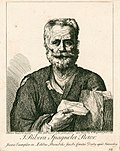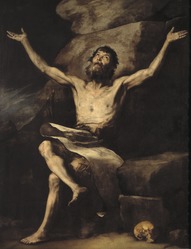File:St Paul the Hermit - Nationalmuseum - 18499.tif

File originale (2 683 × 3 502 pixel, dimensione del file: 26,9 MB, tipo MIME: image/tiff)
| Questo file e la sua pagina di descrizione (discussione · modifica) si trovano su Wikimedia Commons (?) |
| anonimo: St Paul the Hermit
|
|||||||||||||||||||||||||||
|---|---|---|---|---|---|---|---|---|---|---|---|---|---|---|---|---|---|---|---|---|---|---|---|---|---|---|---|
| Artista |
artist QS:P170,Q4233718,P1774,Q297838 |
||||||||||||||||||||||||||
| Titolo |
English: St Paul the Hermit Svenska: St Paulus Eremiten |
||||||||||||||||||||||||||
| Tipo di oggetto |
dipinto object_type QS:P31,Q3305213 |
||||||||||||||||||||||||||
| Genere |
arte religiosa |
||||||||||||||||||||||||||
| Descrizione |
English: Paul of Thebaid was considered the first of the hermits of Egypt – men and women who, to escape persecution as Christians in the 3rd century, chose a life of solitude for the sake of contemplation and asceticism. According to tradition, Paul remained in the desert for almost ninety years, wearing only a garment of woven palm leaves and subsisting on fruit and bread. Edifying images of the hermits’ lives, expressing the value of penitence, were popular subjects in counter-reformation art. Ribera’s portrayal demonstrates a rare understanding of Caravaggio’s lesson. The depicted moment represents the story’s emotional climax, Paul’s ecstatic vision and mystic communion with God, symbolised by the light. The saint’s pose, with its reference to the crucified Christ, indicates his willingness to heed Christ’s call to follow him. His emaciated body is rendered with intransigent realism, every anatomical defect scrupulously transcribed. This stands in sharp contrast to the intense spirituality that radiates from his face. By working with a live model, the artist created an intensely human hero, a modern Saint Paul, and thus established an accessible role model for the faithful to emulate. Svenska: Paulus av Thebe ansågs vara den förste av de egyptiska eremiterna – kvinnor och män som för att undkomma förföljelsen av kristna på 200-talet valde ett liv i avskildhet och ägnade sig åt kontemplation och askes. Enligt traditionen tillbringade Paulus nästan nittio år i öknen, där han endast iklädd ett plagg av vävda palmblad livnärde sig på frukt och bröd. Som uttryck för botens sakrament hade motreformationens bilder på de tidigkristna eremiterna ett uppbyggligt syfte. Riberas gestaltning av botgöraren visar en djup insikt i Caravaggios konst. Ögonblicket utgör berättelsens känslomässiga klimax, där ljuset får symbolisera Paulus extatiska uppenbarelse och inre dialog med Gud. Hans pose anspelar på den korsfäste Kristus och antyder beredvillighet att lyssna till kallelsen att följa honom. Den utmärglade kroppen är avbildad med en orubblig realism och varje anatomisk ofullkomlighet är noggrant återgiven. Detta i kontrast till anletet som utstrålar andlighet. Genom att måla efter levande modell skapar konstnären bilden av en djupt mänsklig karaktär, en modern S:t Paulus, som erbjuder den troende en förebild att identifiera sig med. |
||||||||||||||||||||||||||
| Descrizione originale InfoField | English: Paul of Thebaid was considered the first of the hermits of Egypt – men and women who, to escape persecution as Christians in the 3rd century, chose a life of solitude for the sake of contemplation and asceticism. According to tradition, Paul remained in the desert for almost ninety years, wearing only a garment of woven palm leaves and subsisting on fruit and bread. Edifying images of the hermits’ lives, expressing the value of penitence, were popular subjects in counter-reformation art. Ribera’s portrayal demonstrates a rare understanding of Caravaggio’s lesson. The depicted moment represents the story’s emotional climax, Paul’s ecstatic vision and mystic communion with God, symbolised by the light. The saint’s pose, with its reference to the crucified Christ, indicates his willingness to heed Christ’s call to follow him. His emaciated body is rendered with intransigent realism, every anatomical defect scrupulously transcribed. This stands in sharp contrast to the intense spirituality that radiates from his face. By working with a live model, the artist created an intensely human hero, a modern Saint Paul, and thus established an accessible role model for the faithful to emulate. Svenska: Paulus av Thebe ansågs vara den förste av de egyptiska eremiterna – kvinnor och män som för att undkomma förföljelsen av kristna på 200-talet valde ett liv i avskildhet och ägnade sig åt kontemplation och askes. Enligt traditionen tillbringade Paulus nästan nittio år i öknen, där han endast iklädd ett plagg av vävda palmblad livnärde sig på frukt och bröd. Som uttryck för botens sakrament hade motreformationens bilder på de tidigkristna eremiterna ett uppbyggligt syfte. Riberas gestaltning av botgöraren visar en djup insikt i Caravaggios konst. Ögonblicket utgör berättelsens känslomässiga klimax, där ljuset får symbolisera Paulus extatiska uppenbarelse och inre dialog med Gud. Hans pose anspelar på den korsfäste Kristus och antyder beredvillighet att lyssna till kallelsen att följa honom. Den utmärglade kroppen är avbildad med en orubblig realism och varje anatomisk ofullkomlighet är noggrant återgiven. Detta i kontrast till anletet som utstrålar andlighet. Genom att måla efter levande modell skapar konstnären bilden av en djupt mänsklig karaktär, en modern S:t Paulus, som erbjuder den troende en förebild att identifiera sig med. |
||||||||||||||||||||||||||
| Data |
1644 date QS:P571,+1644-00-00T00:00:00Z/9 |
||||||||||||||||||||||||||
| Tecnica/materiale |
olio su tela medium QS:P186,Q296955;P186,Q12321255,P518,Q861259 |
||||||||||||||||||||||||||
| Dimensioni |
|
||||||||||||||||||||||||||
| Collezione |
institution QS:P195,Q842858 |
||||||||||||||||||||||||||
| Numero d'inventario |
NM 1496 |
||||||||||||||||||||||||||
| Esposizioni |
|
||||||||||||||||||||||||||
| Iscrizioni |
Svenska: Signerad: Jusepe de Ribera espanol F.A. 1644 |
||||||||||||||||||||||||||
| Riferimenti | |||||||||||||||||||||||||||
| Fonte/Fotografo | NM 1496 | ||||||||||||||||||||||||||
| Licenza (Riusare questo file) |
|
||||||||||||||||||||||||||
Didascalie
Elementi ritratti in questo file
raffigura
St Paul the Hermit inglese
Cronologia del file
Fare clic su un gruppo data/ora per vedere il file come si presentava nel momento indicato.
| Data/Ora | Miniatura | Dimensioni | Utente | Commento | |
|---|---|---|---|---|---|
| attuale | 16:56, 7 ott 2016 |  | 2 683 × 3 502 (26,9 MB) | AndreCostaWMSE-bot | {{Artwork |other_fields_1 = |artist = {{Creator:José de Ribera|workshop of}} |title = {{en|St Paul the Hermit}} {{sv|St Paulus Eremiten}} |wikidata = |object_type = |description... |
Pagine che usano questo file
La seguente pagina usa questo file:
Utilizzo globale del file
Anche i seguenti wiki usano questo file:
- Usato nelle seguenti pagine di en.wikipedia.org:
- Usato nelle seguenti pagine di fr.wikipedia.org:
- Usato nelle seguenti pagine di www.wikidata.org:
Metadati
Questo file contiene informazioni aggiuntive, probabilmente aggiunte dalla fotocamera o dallo scanner usati per crearlo o digitalizzarlo. Se il file è stato modificato, alcuni dettagli potrebbero non corrispondere alla realtà.
| Larghezza | 2 683 px |
|---|---|
| Altezza | 3 502 px |
| Bit per campione |
|
| Schema di compressione | Senza compressione |
| Struttura dei pixel | RGB |
| Posizione dei dati immagine | 18 022 |
| Numero delle componenti | 3 |
| Numero righe per striscia | 3 502 |
| Numero di byte per striscia compressa | 28 187 598 |
| Risoluzione orizzontale | 300 punti per pollice (dpi) |
| Risoluzione verticale | 300 punti per pollice (dpi) |
| Disposizione dei dati | a blocchi (chunky) |
| Software | Adobe Photoshop 7.0 |
| Data e ora di modifica del file | 08:57, 29 set 2004 |
| Spazio dei colori | Non calibrato |






